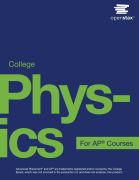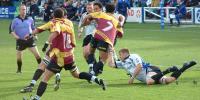

Choose a Chapter from OpenStax College Physics for AP© Courses
Welcome to the internet's best resource to learn physics problem solving! Three years in the making, this enormous collection demonstrates best practices for solving any type of physics problem. Each video is concise, but without skipping steps, to help get you on your way as quickly as possible. I hope you will find the help you need. Download the textbook for free from OpenStax. Best wishes with your studies!
- Shaun Dychko, B.Sc., B.Ed.
-
 Chapter 1Measurement and the scientific method.36 solutions
Chapter 1Measurement and the scientific method.36 solutions -
 Chapter 2One-dimensional kinematics73 solutions
Chapter 2One-dimensional kinematics73 solutions -
 Chapter 3Two-Dimensional Kinematics74 solutions
Chapter 3Two-Dimensional Kinematics74 solutions -
 Chapter 4Dynamics: Force and Newton's Laws of Motion86 solutions
Chapter 4Dynamics: Force and Newton's Laws of Motion86 solutions -
 Chapter 5Further applications of Newton's Laws: friction, drag, and elasticity48 solutions
Chapter 5Further applications of Newton's Laws: friction, drag, and elasticity48 solutions -
 Chapter 6Gravitation and uniform circular motion54 solutions
Chapter 6Gravitation and uniform circular motion54 solutions -
 Chapter 7Work, Energy, and Energy Resources108 solutions
Chapter 7Work, Energy, and Energy Resources108 solutions -
 Chapter 8Linear Momentum and Collisions113 solutions
Chapter 8Linear Momentum and Collisions113 solutions -
 Chapter 9Statics and Torque50 solutions
Chapter 9Statics and Torque50 solutions -
 Chapter 10Rotational Motion and Angular Momentum77 solutions
Chapter 10Rotational Motion and Angular Momentum77 solutions -
 Chapter 11Fluid statics90 solutions
Chapter 11Fluid statics90 solutions -
 Chapter 12Fluid Dynamics and its Biological and Medical Applications.74 solutions
Chapter 12Fluid Dynamics and its Biological and Medical Applications.74 solutions -
 Chapter 13Temperature, Kinetic Theory, and the Gas Laws80 solutions
Chapter 13Temperature, Kinetic Theory, and the Gas Laws80 solutions -
 Chapter 14Heat and Heat Transfer Methods88 solutions
Chapter 14Heat and Heat Transfer Methods88 solutions -
 Chapter 15Thermodynamics77 solutions
Chapter 15Thermodynamics77 solutions -
 Chapter 16Oscillatory Motion and Waves101 solutions
Chapter 16Oscillatory Motion and Waves101 solutions -
 Chapter 17Physics of Hearing106 solutions
Chapter 17Physics of Hearing106 solutions -
 Chapter 18Electric charge and electric field106 solutions
Chapter 18Electric charge and electric field106 solutions -
 Chapter 19Electric Potential and Electric Field112 solutions
Chapter 19Electric Potential and Electric Field112 solutions -
 Chapter 20Electric Current, Resistance, and Ohm's Law109 solutions
Chapter 20Electric Current, Resistance, and Ohm's Law109 solutions -
 Chapter 21Circuits, Bioelectricity, and DC Instruments90 solutions
Chapter 21Circuits, Bioelectricity, and DC Instruments90 solutions -
 Chapter 22Magnetism105 solutions
Chapter 22Magnetism105 solutions -
 Chapter 23Electromagnetic Induction, AC Circuits, and Electrical Technologies111 solutions
Chapter 23Electromagnetic Induction, AC Circuits, and Electrical Technologies111 solutions -
 Chapter 24Electromagnetic Waves62 solutions
Chapter 24Electromagnetic Waves62 solutions -
 Chapter 25Geometric Optics82 solutions
Chapter 25Geometric Optics82 solutions -
 Chapter 26Vision and Optical Instruments49 solutions
Chapter 26Vision and Optical Instruments49 solutions -
 Chapter 27Wave Optics116 solutions
Chapter 27Wave Optics116 solutions -
 Chapter 28Special Relativity76 solutions
Chapter 28Special Relativity76 solutions -
 Chapter 29Introduction to Quantum Physics102 solutions
Chapter 29Introduction to Quantum Physics102 solutions -
 Chapter 30Atomic Physics83 solutions
Chapter 30Atomic Physics83 solutions -
 Chapter 31Radioactivity and Nuclear Physics93 solutions
Chapter 31Radioactivity and Nuclear Physics93 solutions -
 Chapter 32Medical Application of Nuclear Physics71 solutions
Chapter 32Medical Application of Nuclear Physics71 solutions -
 Chapter 33Particle Physics68 solutions
Chapter 33Particle Physics68 solutions -
 Chapter 34Frontiers of Physics29 solutions
Chapter 34Frontiers of Physics29 solutions